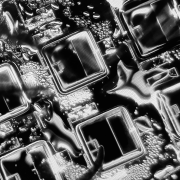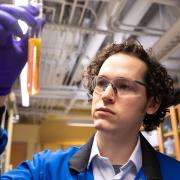Much of the world we see around us is made up of complicated molecules. If you go to the store, virtually everything you see—every bottle of nail polish, every bag of lawn fertilizer, and every pill—starts with chemists figuring out how to make the exact right molecule consistently.
A new method demonstrated by chemists at the University of Chicago shows how to build certain molecules much more efficiently and easily, using a “placeholder” method that sidesteps previously difficult and wasteful processes.
These molecules are commonly used in making medications, so the scientists believe it could make the process of discovering new drugs faster and easier. But they also hope the paper, published April 3 in Nature, suggests new approaches for other areas of chemical synthesis.
“When you’re making a lot of these molecules, called pyrazoles, you often get a mixture of two products when you only want one, and they’re quite difficult to separate,” said Alexander Fanourakis, a postdoctoral researcher at the University of Chicago and first author on the paper. “Our approach lets you consistently produce only the molecule you want—which we hope could open new doors.”
‘The shape is everything’
When you’re making a molecule, you have to make sure every atom in the molecule is in the proper place. “The shape is everything. For example, if you’re making drugs, molecules that are connected properly are medicine. A molecule that is not connected properly is no longer a medicine, and may even be harmful,” said Mark Levin, associate professor of chemistry at UChicago and senior author on the paper.
To build this molecule correctly, you need a very good recipe. If you combine the ingredients for a cake in the wrong order, the recipe won’t work. Likewise, molecules need to be crafted in a very precise series of steps.
One such commonly used class of molecules is known as pyrazoles. They are used in many drugs and also to make agricultural chemicals, such as fungicides. Though useful, these molecules had a persistent issue.
“The reaction to make them is simple, but it almost always gives a mixture of two end products, so you then have to spend time and effort to purify it to get only the one you want,” explained Fanourakis. “To make matters worse, sometimes you’re only interested in the minor end product, meaning that you have to throw the majority of your yield away, which is very wasteful.”
The biggest problem lies in a step that requires two different kinds of atoms to latch onto different landing sites on the molecule. But to an atom, these two landing sites look basically the same. Usually, chemists just have to sigh and accept that some of each atom will wind up on both sites, and the batch will yield at least some of the incorrect one.
“We took a step back and said, what if we turn this into a different problem entirely?” said Yahia Ali, graduate student and second author of the paper.
Instead, the team engineered a new process in which they build the molecule through a different route—tapping a class of previously underexplored reactions—so that one of the tricky landing sites is occupied by an atomic “placeholder” while its compatriot is filled. Then, further reactions directly swap the placeholder for the desired set of atoms.
The team tested the method with different types of molecules, some of which are normally extremely difficult to make without creating byproducts. “These sites are incredibly subtly differentiated, and we can get perfect selectivity,” said Levin.
“We’re excited because it’s a new way to address a very fundamental problem,” said Ali.
Time and energy saved
Every step saved in chemistry is not only time saved, but also energy, waste and by-products. Especially when these processes are scaled up to make what you’d need for commercial production, fewer steps can result in significantly greener manufacturing.
In particular, the scientists think the new approach will be very useful for the process of drug discovery.
“As part of the process of designing a drug, you don’t immediately know what the exact structure of molecule you’ll need to produce the right effect, and so you usually have to make a bunch of them and test,” explained Fanourakis.
But if every single small variation requires you to have to stop and figure out how to purify it, that can slow down progress considerably.
“With our method, you can make a batch of our intermediate molecule and have a guarantee that whatever you put on it will go exactly where you want it to,” said Ali. “So we hope that should simply the process of those kinds of experiments quite a bit.”
In addition, Levin said he thinks even the concept itself has legs for other areas of chemistry.
“Since Alex and Yahia made those early discoveries in the lab, before we even submitted this paper, it has begun to influence the way that other people in the lab have thought about their projects,” he said. “The idea that you can use these atom replacements even to control selectivity has been eye-opening for us, and I think it may be for others, too.”
Other University of Chicago authors on the paper were undergraduate student Liao Chen, then-graduate student Patrick Kelly (PhD’24), and graduate student Abigail Bracken, in addition to Johnson & Johnson chemist Christopher Kelly.
Citation: “Strategic atom replacement enables regiocontrol in pyrazole alkylation.” Fanourakis et al, Nature, April 3, 2025.
Funding: Packard Foundation, Bristol Myers Squibb, University of Chicago Quad Scholars Grant, National Science Foundation, Seymour Goodman Fund.

